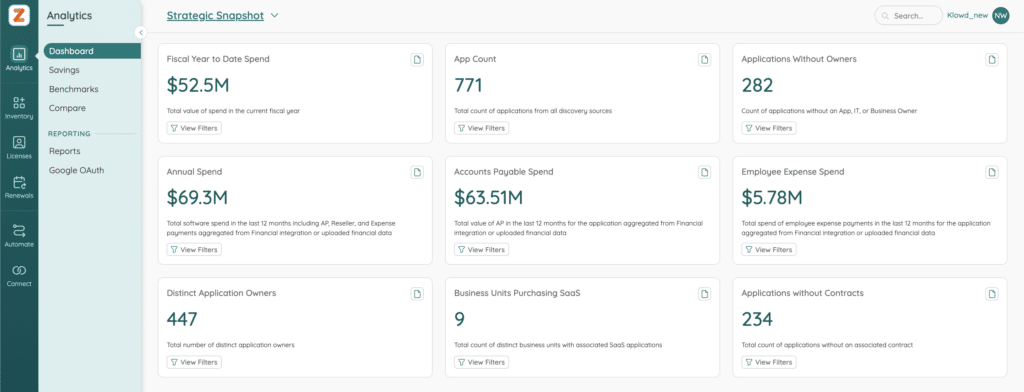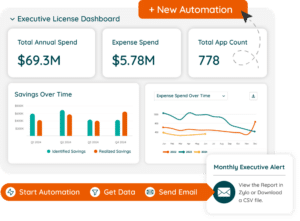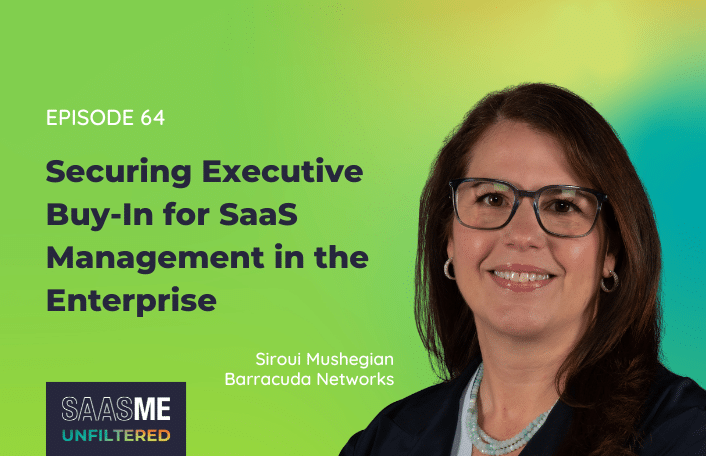
Use This Data Storytelling Framework to Gain Executive Support for SaaS Management
Table of Contents ToggleSuccessful SaaS Management Requires Executive Prioritization and Commitment5...
Back
Back
Search for Keywords...
Blog

Table of Contents
SaaS Management is not just a departmental task – it’s a company-wide program. To ensure it is prioritized, you must have executive support. Engaging your CIO and/or CFO elevates SaaS Management to a company-wide priority, fostering cooperation and alignment across departments.
Yet, that’s easier said than done. One way to gain executive prioritization and commitment to your SaaS Management program is with an executive dashboard.
Executives want concise reporting on key metrics that matter to them. When data is convoluted or comes with caveats, they lose interest and start questioning its relevance. Plus, sharing (and reading) the information can be time consuming, especially when you use spreadsheets (Excel) or presentation decks (PowerPoint). Who wants to scroll through endless rows, columns, and pages to decode the data?
“If you consider how many functions and teams interact with software, from planning procurement to the end of a software lifecycle, it’s clear that alignment cannot solely be achieved by a SAM team or a SaaS Management program alone. It invariably requires an executive sponsor.”
— Shravya Ravi, Head of Software and IT Hardware Asset Management at LinkedIn
The solution?
Implementing a dynamic SaaS Management executive dashboard can address these challenges. The dashboard should be easy to understand and use and also:
By using a dynamic executive dashboard, you ensure that essential data is accessible, compelling and straightforward. Ultimately, it facilitates better decision-making and stronger executive engagement in your SaaS Management efforts. An executive dashboard essential for aligning SaaS Management with broader business objectives, demonstrating ongoing value, and securing executive support to drive success.
An executive dashboard is a crucial component of the reporting function within a SaaS Management Platform (SMP). It serves as a visual representation of data and a strategic tool that aligns with and supports the company’s broader goals. When planning your executive dashboard, keep these five key considerations in mind to ensure it effectively meets the needs of your organization and its leaders.
The primary purpose of your SaaS Management dashboard should be to demonstrate how SaaS initiatives support the company’s strategic objectives. This means that the data presented must directly correlate with what the company aims to achieve in the broader scope. Common strategic goals that SaaS Management can support include:
The executive dashboard should not be overwhelmed with data. Instead, focus on what’s most important to your executive team. Include key metrics that provide a snapshot of the SaaS landscape within your organization:

When presenting data, it’s vital to frame it in a way that resonates with each executive’s interests and responsibilities. The executive dashboard should convey information and tell a compelling story of how SaaS Management makes a difference, appealing to each stakeholder’s priorities.
Siroui Mushegian, CIO at Barracuda Networks, calls it the ‘what’s in it for me’ story. “You have to find the currency that’s important for each leader that’s going to grab them and make them interested. Dollar signs are really pervasive across all stakeholders,” explained Mushegian.
By addressing what’s important to each stakeholder, you can create a SaaS Management executive dashboard that delivers impactful data and meaningfully engages executives. Pairing that with a ‘what’s in it for me’ story reinforces their commitment and support for your SaaS Management program.
Listen to the podcast clip below for more from Siroui Mushegian on telling ‘what’s in it for me’ stories around SaaS Management.
To keep your executive team engaged, it’s important to meet regularly – at least quarterly. Consider it a routine health checkup but for your SaaS Management program. Sure, nothing is wrong right now. But how else do you measure progress or watch for problems on the horizon?
Regular reporting helps demonstrate the continuing value of your SaaS Management program and monitor its health through scheduled check-ins. As an added bonus, it helps enhance accountability and drive prioritization of key business opportunities.
Your executive team should always have access to a dynamic SaaS Management dashboard. However, we all know how busy they are. Automate the distribution of the dashboard to executives ahead of the conversation. Then, it becomes a more effective and strategic discussion the day of the meeting.
“In a quarterly rhythm, we provide our executives a snapshot of how we’re doing with tech governance. That includes everything from identifying where we have opportunities, to detailing where we’ve successfully reduced licenses, to strategizing big decisions for the next quarter around upcoming contracts, licenses, and partnerships.”
— Trenton Cycholl, VP of IT and Digital Business at ModMed
Beyond the figures and graphs, building solid relationships with your executive team is vital for the success of any reporting strategy. Gaining this rapport helps build mutual trust, ensuring the focus stays on the information you bring to the table.
“The next move was figuring out how to get this in front of our executives and make it a critical corporate objective that needs everyone’s attention,” shared Mushegian. “I developed a strong rapport with the executive team, ensuring that when I joined the leadership team meetings, I brought something significant—a problem that needed awareness or support.”
With Zylo’s Dashboards & Custom Widgets, communicating SaaS data, insights, and the overall business impact of SaaS Management to executive leadership becomes straightforward and impactful. Zylo offers the most flexible configuration of dashboards and widgets available, making it easier than ever to demonstrate the value your program brings, identify top opportunities for improvement, and monitor the overall performance of your SaaS Management efforts.
 Streamline Dashboard Creation and Assignment: Ensure that the right people have access to the right information exactly when needed.
Streamline Dashboard Creation and Assignment: Ensure that the right people have access to the right information exactly when needed.Ready to see how Zylo can transform your SaaS Management reporting? Request a demo today and start making better-informed decisions that drive your business forward.

Table of Contents ToggleSuccessful SaaS Management Requires Executive Prioritization and Commitment5...

Table of Contents ToggleWhy SaaS Usage Metrics Matter More Than EverThe...

Table of Contents ToggleEpisode SummaryGuest SpotlightEpisode HighlightsBuild Rapport & Use Data...

Table of Contents ToggleSuccessful SaaS Management Requires Executive Prioritization and Commitment5...
| Cookie | Duration | Description |
|---|---|---|
| cookielawinfo-checkbox-analytics | 11 months | This cookie is set by GDPR Cookie Consent plugin. The cookie is used to store the user consent for the cookies in the category "Analytics". |
| cookielawinfo-checkbox-functional | 11 months | The cookie is set by GDPR cookie consent to record the user consent for the cookies in the category "Functional". |
| cookielawinfo-checkbox-necessary | 11 months | This cookie is set by GDPR Cookie Consent plugin. The cookies is used to store the user consent for the cookies in the category "Necessary". |
| cookielawinfo-checkbox-others | 11 months | This cookie is set by GDPR Cookie Consent plugin. The cookie is used to store the user consent for the cookies in the category "Other. |
| cookielawinfo-checkbox-performance | 11 months | This cookie is set by GDPR Cookie Consent plugin. The cookie is used to store the user consent for the cookies in the category "Performance". |
| viewed_cookie_policy | 11 months | The cookie is set by the GDPR Cookie Consent plugin and is used to store whether or not user has consented to the use of cookies. It does not store any personal data. |
